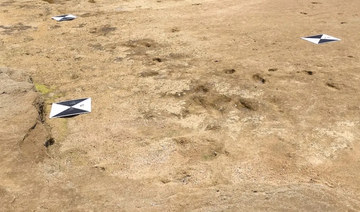TUNIS: On a corner by the entrance to Tunis zoo, Leila waits for a hot meal from the Tunisian capital’s “Restaurant of Love” in a cardboard shelter where she and her dogs sleep.
The 50-year-old says she has been living on the streets for more than 27 years.
“I don’t want to go to the shelter centers,” and feels safer in her makeshift abode, despite the dangers of robbery and violence on the street, she says as she fixes a plastic cover over her bed for the cold winter night.
Leila is always happy to see the volunteers from the NGOs Universelle and Samu Social when they bring her food and clothing every Friday night.
For the rest of the week, she often has to make do with no more than a tin of sardines.

Volunteers from the NGO Salut Social check on homeless people preparing to spend the night on a street in Tunis on January 26, 2024. (AFP)
The Friday night meal is from the kitchen of the “Restaurant of Love,” a charitable initiative launched by Universelle three years ago to help feed the growing number of Tunis’ homeless.
There are no official data on the exact number of people living on the streets in the capital, but it is estimated to be in the hundreds.
The “Restaurant of Love” is the “first of its kind” in Tunisia, says Nizar Khadhari, the 39-year-old head of Universelle.
The idea is simple — a regular eatery affordable for everyone, with a plate of pasta costing just 4.5 dinars or $1.40.

Leila and another homeless man share the Friday night dinner offered by the "Restaurant of Love", a charitable initiative launched three years ago to help feed the growing number of Tunis' homeless, in her cardboard shelter where she and her dogs sleep, in Tunis on January 26, 2024. (AFP)
Homeless people can eat there for free — accounting for around 30 percent of the 400-450 meals served there every day.
But paying customers can also make donations in a tin by the cash register to help cover the costs.
“All profits go to the homeless, and we also employ some of them... We try to motivate them to return and integrate into society,” says Khadhari.
“The economic situation is hitting this vulnerable group of people particularly hard,” says Khadhari, who predicts that the number of rough sleepers in the capital will continue to grow “due to rising prices and a lack of job opportunities.”
According to World Bank data, growth of the North African country’s highly indebted economy stood at just 1.2 percent in 2023, while inflation stood at 8.3 percent in 2022.
And with the economic woes exacerbated by the Covid-19 pandemic and soaring food prices in the wake of the war in Ukraine, poverty rates are on the rise in the population of 12 million.
According to official statistics, the poverty rate in Tunisia stood at 16.6 percent nationwide in 2021 but was nearer 25 percent in rural areas.
Many Tunisians flee the poorer regions in the interior of the country to coastal cities in the hope of finding work.
But with no luck when they get there, they often find themselves with nowhere to live.
Some are kicked out by their families or suffer from mental health problems and can often only find shelter in a metro or bus station.
Sabri, a man in his thirties who makes a living selling paper handkerchiefs on the street, says he has repeatedly tried to kill himself.
“I’m tired of being on the street for 20 years,” he says, and sees “no solution” in sight.
Last year, Tunisia’s ministry of social affairs said it helped 223 homeless people in the greater Tunis area. But in other areas of the country, such help is non-existent.
“The economic impact on vulnerable people cannot be ignored, and there are programs to help them,” said Rafik Bouktif, a ministry of social affairs official who heads a shelter center in Tunis.
The center is home to about 50 people and has a budget of 400,000 dinars ($128,000) to work with Universelle and Samu Social in the greater Tunis region.
“Combining state resources with those of NGOs is a sure way of reaching more people,” says Bouktif.
Nevertheless, “while ambitions are great, the means remain limited.”
The “Restaurant of Love” recently moved from the outskirts of the city to downtown Tunis. And the paying customers — from all walks of life — think it’s a great idea.
“We eat while we feed others,” says Asmaa, a government worker who eats there every day after finding out about it on social media.




























